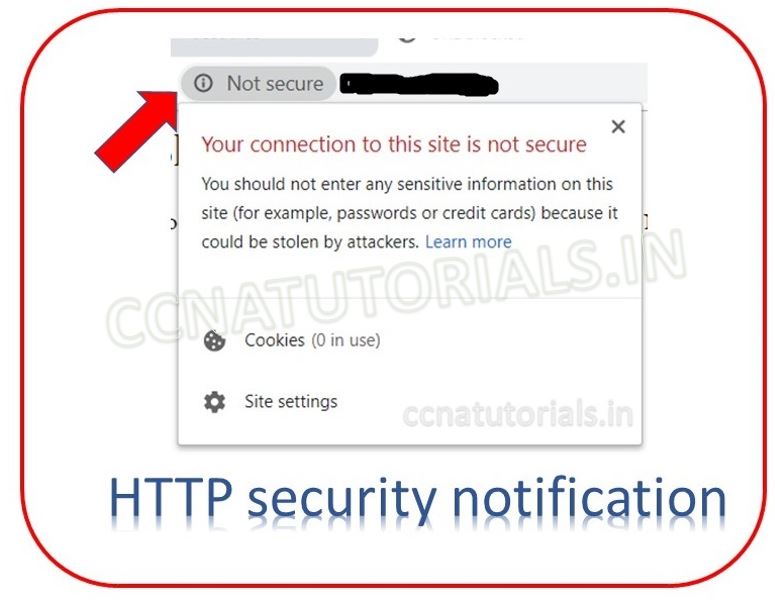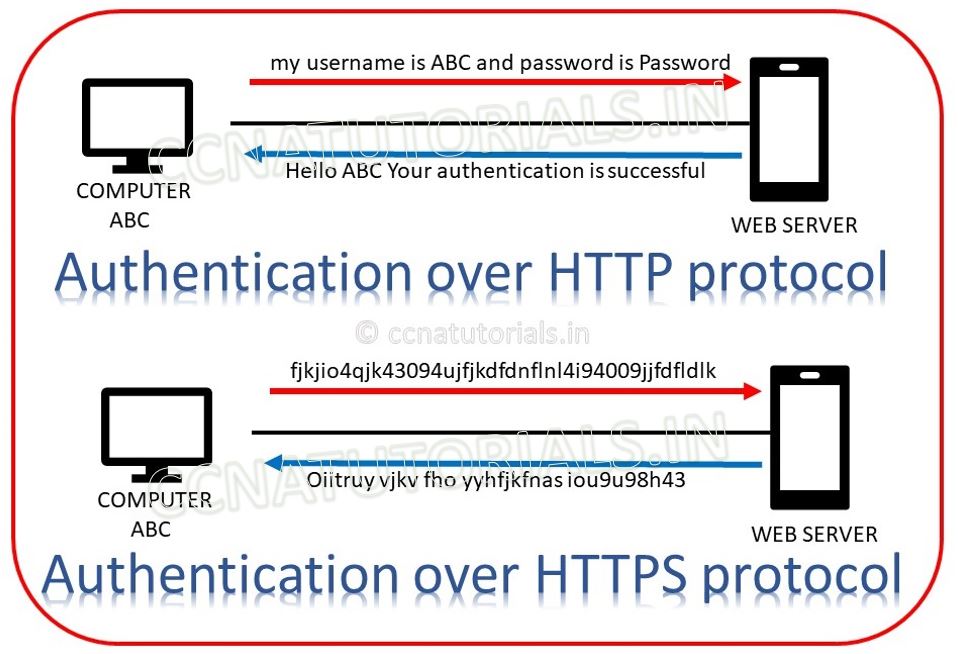In this article I describe the HTTPS Hypertext Transfer Protocol Secure in computer network for CCNA exam. HTTPS Hypertext Transfer Protocol Secure is related to web services in TCP/IP Suite model. The HTTPS Hypertext Transfer Protocol Secure allowed to browse the web service from a web server in the network or internet. HTTPS Hypertext Transfer Protocol Secure is very useful to access the web server in the network from a computer or endpoint device. The HTTPS Hypertext Transfer Protocol Secure is an application layer protocol in TCP/IP suite model. HTTPS is advance version of HTTP. You can read the full article about the HTTP here.
The encrypted data transferred over a secure connection via HTTPS Hypertext Transfer Protocol Secure. The TLS or SSL used to keep secure the data transfer from a web server over internet. The encryption done on both server and client end when a site uses HTTPS link.
HTTPS Hypertext Transfer Protocol Secure allow to access the text, graphics, audio and video data from the web server on port 443 in the network. A user can access the web server by typing the domain name in the browser. The DNS protocol convert the DNS name into the related IP address of web server on the internet. It may be beneficial to know about the layered approach in the OSI and TCP/IP suite model.
Before going to learn about HTTPS Hypertext Transfer Protocol Secure we should remember the OSI suite and TCP/IP suite model. There are many manufacturer of computer machine in the market. Initially when computers became single user public computer. The computers communicate with only same brand machines. It happens because there was no any fix standard for data transfer between different devices. It is very difficult to make communication with each other when the hardware are of different brands or company. In this article I describe the some basic part of OSI reference layer and TCP/IP Suite model basic concepts in networking with FTP File Transfer Protocol.
OSI reference model in computer network followed by various vendors to overcome the compatibility problem. After implementation of OSI reference model in computer network, equality maintains by all manufacturer. In 1970 the Open Systems Interconnection (OSI) reference model was created by the International Organization for Standardization (ISO). The OSI model was meant to create inter-operable network with different manufactured devices. In this article I describe some layered approach of TCP/IP Suite model basic concepts in computer network. Before understanding the TCP/IP Suite model basic concepts it is necessary to know about the 7 layers of OSI reference model because the basic work of each layer is described in the OSI reference model. You can read the full article related to OSI reference model in computer networking here.
Importance of OSI reference model
Before going to know about the HTTP Hypertext Transfer Protocol. It is necessary to know the function of application layer in OSI model and TCP/IP model. Initially not only hardware but software also not supported for work the different computer brand. It became very difficult for all computer users to working without implementation of OSI reference model in computer network. It is necessary then to make some common protocols for all vendors of computer. Before implementation of OSI reference model in computer network, all vendors implements their own protocols on computer hardware and software.
In networking OSI reference model became helpful. OSI reference model describes the flow of data between nodes in any network. Data from one computer application to another computer application transfer by following some common protocols. The OSI reference layer also become beneficial for troubleshooting the network problems. TCP/IP and Cisco three layered hierarchical model of Cisco became more helpful alongside the OSI reference model.
The Layered Approach in computer network for HTTPS Hypertext Transfer Protocol Secure
The Layered approach was the best way to make equality for all computer devices. Layers are not physical but following some protocols. Protocols are for connectivity, connections, data transfer and more. All manufacturer begin to follow the layered approach for OSI reference model in computer network. The OSI reference model change in TCP/IP reference model and later on Cisco three layered hierarchical model. OSI layer architecture have 7 layers. TCP/IP reference model convert these 7 layers into only four layers. After that Cisco three layered hierarchical model converts these 7 layers into three layers. Some layers combined to work in a single layer.
OSI is acronym for open system interconnection. The OSI is a logical reference OSI reference model in computer network. OSI model helps for data flow between different devices and operating systems. All manufacturer used their own architecture before invention of OSI reference model. It was very difficult to establish data communication between different devices. To overcome this problem international organization for standardization (ISO) created the open systems interconnection (OSI) reference model. OSI reference model make data flow possible between different operating system, devices and hardware. Later the OSI model adopted by Cisco as Cisco three layered hierarchical model.
Structure of OSI reference model
OSI reference model in computer network consist of 7 layers. These 7 layers further divided into two groups. First 3 layers works for application communication and remaining 4 layers works for data flow. Application, presentation and session layers define the application communication. Transport, network, data link and physical layers define the data flow. Networking protocols works only on last four layers.
TCP/IP Suite model basic concepts
TCP/IP is acronym for Transmission Control Protocol/Internet Protocol (TCP/IP suite model). In this section of the article I describe about TCP/IP suite model basic concepts in detail. TCP/IP suite model is a reference model like OSI layers. Instead of 7 layers of OSI reference model. TCP/IP suite model consist only four layer. All seven layers are merged into four layers only. TCP/IP suite model was designed and implemented by Department of Defence (DoD). TCP/IP developed to preserve data integrity. The main purpose to develop the TCP/IP is to provide security in the network. A lots of protocols works on each layer to provide a secure network.
It is necessary to understood the protocols used in TCP/IP Suite model basic concepts. IP addressing play an important role in TCP/IP Suite model basic concepts. By using the IP address and subnet masking broadcast domain breaks. It will improve the performance of the network. Breaking broadcast domain increase the data flow speed. Here IP stands for IPV4 only. We ignore the IPV6 for some time in this article. It will make it easy to understand the TCP/IP Suite model basic concepts.
A snap of TCP/IP Suite model basic concepts
In the decade of 1970’s TCP/IP suite model developed by DoD. In the initial stage TCP/IP suite model divided into two segments TCP and IP. Later its name registered with combined name of TCP and IP like TCP/IP model. ARPA, the Advanced Research Projects Agency of DoD officially authorised to use TCP/IP suite model. TCP/IP model was working well so it was adopted by many organisations. In today scenario it is mostly using reference model for networking. Internet is the best example of using TCP/IP.

Basic Idea of Layers of TCP/IP Suite model
There are four layers in DoD model. As shown in above image. Top 3 layers of OSI combined and create the Process/Application layer. Transport layer remain Transport layer. Network layer become internet layer and last two layer combined and called link layer. You can see both model are similar in concept.
Process or Application layer of DoD model in TCP/IP Suite model
This is the first layer of TCP/IP of DoD model. It is combination of top three layers of OSI reference model. The functions of Application layer, presentation layer and session layer in OSI model works in single layer process layer. This layer supports the point to point communication and controls the user interface. The data encryption and decryption also done at this layer. Example of some protocols functions at this layer are Telnet, FTP, LPD, TFTP, SMTP.
Transport layer of DoD model in TCP/IP Suite model
Transport layer of TCP/IP is same as the Transport layer of OSI reference model. It supports the TCP and UDP protocol. This protocol converts the main data segment into packets and transport to the internet layer. The responsibility of Transport layer is to combine the segments and built the data. The data should be reconstruct in its real form. Transport layer is also responsible for creating end-to-end communication between sender and receiver. This layer ensure the delivery of segment in sequence at the receiving device. This property maintains the data integrity.
Internet layer of DoD model in TCP/IP Suite model
Internet layer of TCP/IP is similar to the network layer of OSI reference model. Routing protocols functions on Internet layer of TCP/IP model. Addressing and filtering of packets is main responsibility of Internet layer of TCP/IP model. This layer provides the transmission of packet in the whole network. Some example of protocols functions on internet layer are ICMP, ARP and IP.
Link layer of DoD model in TCP/IP Suite model
Link layer is the least layer of TCP/IP. Basically link layer is combination of data link and physical layer of OSI reference model. Link layer is also known as Network Access layer. It works on MAC address based data transmission. Link layer handles the frame and bits. It receive the bits and constructs frame from merging bits in a sequence. In case of any bit is missing this layer request to re transmit the bits. Ethernet, FDDI, WAP etc functions on this layer. There is no any preset specification for link layer. Link layer functions on any type of existing media.
HTTPS Hypertext Transfer Protocol Secure explained
HTTPS Hypertext Transfer Protocol Secure is the secure version of HTTP. The HTTPS Hypertext Transfer Protocol Secure provides secure data sharing from web servers on internet. HTTPS protocol uses separate ports 443 on network. HTTPS protocol invented to overcome the security breaches of HTTP protocol. Credentials of a user are very important; HTTPS keep these credentials secure. HTTPS protects against man-in-the-middle attacks. The HTTPS provides data encryption and decryption on both server and client side.
Financial, social, railway, airline and email websites always use HTTPS Hypertext Transfer Protocol Secure. These websites have a lot of important information. User credentials and financial information used by these websites. Firstly, HTTPS Hypertext Transfer Protocol Secure used for payment transaction online.

HTTPS Hypertext Transfer Protocol Secure use TLS and SSL for data encryption. TLS and SSL can be used to creates secure path in an insecure network.
Certificates used for HTTPS Hypertext Transfer Protocol Secure
Web browsers pre-programmed to authenticate the HTTP and HTTPS websites. Website hosting server need to install SSL certificate to provide HTTPS connectivity. These certificates are unique for each website. A certificate doesn’t work on another website. Some famous certificate authorities are DigiCert, GoDaddy etc. The below image shows how a secure certificate can be checked.

When you visit a site with HTTPS protocol. There is a lock type symbol available in the address bar of browser. By clicking on the lock, the certificate information can be seen. If the certificate is invalid, then ‘not secure’ display in place of lock. By looking the secure lock, the client trusts that the HTTPS security working properly. The HTTPS encryption layer SSL and TLS is sufficiently secure the data over the internet.

Some web browser indicates the secure site by changing the background color of address bar. Some browsers display a lock in the address bar before HTTPS. Most web browsers give an alert to user if the website is not secure or have invalid security certificates.
Difference between HTTP and HTTPS Hypertext Transfer Protocol Secure
There are two protocols to access a website over the internet. One is HTTP and another is HTTPS. HTTPS is extension of HTTP. In all URLs the prefix is always HTTP or HTTPS. Both protocols used different ports. HTTP uses port 80 and HTTPS uses port 443 by default. HTTP provides access to a website but not securely. HTTPS means to provide security to data accessed by a user on the internet.
- HTTP URL seems like
http://and the HTTPS URL ishttps://. - HTTP is unsecured while HTTPS is secured.
- HTTP uses port 80 while HTTPS uses port 443.
- HTTP operates at application layer, while HTTPS operates at transport layer.
- No any certificates are required for HTTP, SSL or TLS certificates are required to work with HTTPS.
- HTTP requires no encryption while HTTPS required some encryption methods.
Encryption of data in HTTPS protocol
TLS security protocol lie at the lower sub-layer of application layer of TCP/IP model. HTTP belongs to the top level of application layer of TCP/IP model. TLS encrypts the HTTP data before transmission and decrypt the data after received.

HTTP and HTTPS working is shown in above picture. A user passes the information on HTTP to the web server. This information is travel in plane format. Same information sent on HTTPS to the web server is encrypted.
HTTPS Hypertext Transfer Protocol Secure established an encrypted link between the browser and the web server using the Secure Socket Layer (SSL) or Transport Layer Security (TLS) protocols. TLS is the new version of SSL.
In this article I describe the HTTPS Hypertext Transfer Protocol Secure in computer network for CCNA Exam. I hope you found this article helpful. For any query or suggestion you may drop a comment below or contact us. Your suggestions are always welcome by us.






